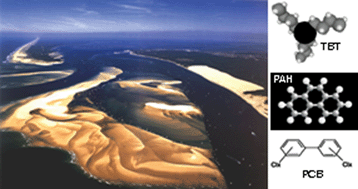Marine mussels Mytilus sp. were transplanted on a monthly basis in cages over one year to oyster farms and harbours in the Arcachon Bay (France) in order to assess the water quality of the bay. Contaminant levels (organotin compounds, trace metals, PCBs and PAHs) were measured in tissues of transplanted mussels and mussels from a reference station, along with physiological parameters of the mussels (condition indexes, lipid content and dry weight). Four biomarkers (AChE: acetylcholinesterase activity, GST: gluthathione S-transferase activity, CAT: catalase activity and TBARS: thiobarbituric acid-reactive substance content) were also monitored. The remote stations monitored (oyster parks) exhibited no accumulation pattern of pollutants. Their respective concentrations therefore constitute a background level of the contamination in the bay ([TBT]
= 30 ng Sn g−1 dw, [ΣHAPs]
= 100 ng g−1 dw, [ΣPCBs]
= 35 ng g−1 dw). The elevated chemical contamination of the largest harbour of the bay, the Arcachon harbour, can be interpreted in terms of persistence of organotin compounds ([ΣOTs]
= 1500–2000 ng Sn g−1 dw) and PAHs ([ΣHAPs]
= 4500–5000 ng g−1 dw) in sediments and, to a lesser extent, of direct inputs of copper ([Cu]
= 20 μg g−1 dw in harbours versus 7 in oyster parks) and petrogenic PAHs ([methylphenanthrenes]
= 1600 ng g−1 dw in the dockyard versus 170 at the gas stations), related to the use of copper-based antifouling paints and to dockyard activity, respectively. However, the Arcachon Bay presents a low contamination level by PCBs and metals, including harbour stations. Furthermore, higher levels of other PAHs (particularly alkyl PAHs such as methylphenanthrenes/1600 ng g−1 dw) not included in the 16 PAHs from the EPA priority list (usually studied in biomonitoring programmes/1500 ng g−1 dw) in the Arcachon harbour underline the need to integrate these compounds in biomonitoring of highly PAH-polluted areas such as harbours in order to avoid misinterpretation of the biological responses observed. Biomarker responses were not able to discriminate the different chemical contamination levels recorded in the Arcachon Bay and rather reflected changes in environmental factors. Furthermore, the strong intraspecies variability of biological responses could be due to genetic differences of mussels from the Arcachon Bay. It is the first time that such an integrated monitoring is performed in the Arcachon Bay, also taking into account seasonal variations of chemical contents and biomarkers levels in mussel tissues.


 Please wait while we load your content...
Please wait while we load your content...